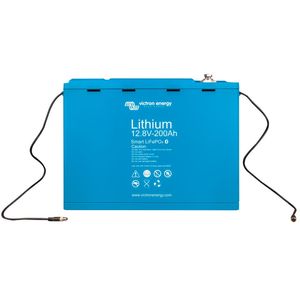Victron Energy Smart LiFePO4 Lithium Battery 12.8V 200Ah BAT512120610
No Longer Available
This item is no longer available from the manufacturer.
Please contact us to enquire about an alternative product.
Technical Specification
| Customer Rating | Not Available |
| Terminals |   |
| Brand | Victron |
| Voltage | 12.8 Volts |
| Technology | Lithium |
| Capacity (C20) | 200 Ah |
| Length | 321 mm |
| Width | 152 mm |
| Height inc. terms | 237 mm |
| Guarantee | 2 Years |
Description
Victron Smart LiFePO4 Lithium Battery (BAT512120610)
Victron Energy can trace its history as far back as 1975 and have become worldwide giants in the industry. Now based in the Netherlands they continue to be industry leaders that others look up to. Victron Energy has a strong, unrivalled reputation for technical innovation, reliability, and build quality with a vast product range of sinewave inverters, sinewave inverters/chargers, battery chargers, DC/DC converters, transfer switches, battery monitors and much more. Victron Energy's products can be found in the leisure, marine, automotive, industrial, solar, telecommunications sectors and more!
Victron Smart LiFePO4 Lithium Batteries
Victron Energy Lithium Battery Smart batteries are Lithium Iron Phosphate (LiFePO4) batteries and are available in 12.8 V or 25.6 V in various capacities. They can be connected in series, parallel and series/parallel so that a battery bank can be built for system voltages of 12 V, 24 V or 48 V. The maximum number of batteries in one system is 20, which results in a maximum energy storage of 84 kWh in a 12 V system and up to 102 kWh in a 24 V1) and 48 V1) system.
A single LFP cell has a nominal voltage of 3.2V. A 12.8 V battery consists of 4 cells connected in series and a 25.6 V battery consists of 8 cells connected in series.
Rugged
A lead-acid battery will fail prematurely due to sulphation:
• If it operates in deficit mode during long periods of time (i.e. if the battery is rarely, or never at all, fully charged).
• If it is left partially charged or worse, fully discharged (yacht or mobile home during wintertime).
A LFP battery:
• Does not need to be fully charged. Service life even slightly improves in case of partial charge instead of a full charge. This is a major advantage of LFP compared to lead-acid.
• Other advantages are the wide operating temperature range, excellent cycling performance, low internal resistance and high efficiency.
LFP is therefore the chemistry of choice for demanding applications.
Efficient
• In several applications (especially off-grid solar and/or wind), energy efficiency can be of crucial importance.
• The round-trip energy efficiency (discharge from 100 % to 0 % and back to 100 % charged) of the average lead-acid battery is 80 %.
• The round-trip energy efficiency of a LFP battery is 92 %.
• The charge process of lead-acid batteries becomes particularly inefficient when the 80 % state of charge has been reached, resulting in efficiencies of 50 % or even less in solar systems where several days of reserve energy is required (battery operating in 70 % to 100 % charged state).
• In contrast, a LFP battery will still achieve 90 % efficiency under shallow discharge conditions.
Size and weight
• Saves up to 70 % in space
• Saves up to 70 % in weight
Expensive?
• LFP batteries are expensive when compared to lead-acid. But in demanding applications, the high initial cost will be more than compensated by longer service life, superior reliability and excellent efficiency.
Bluetooth
• With Bluetooth cell voltages, temperature and alarm status can be monitored.
• Instant readout: The VictronConnect App can display the most important data on the Device list page without the need to connect to the product.
• Very useful to localise a (potential) problem, such as cell imbalance.
Battery Management System (BMS)
The BMS will:
1. Generate a pre-alarm whenever the voltage of a battery cell decreases to less than 3.1 V (adjustable 2.85 V – 3.15 V).
2. Disconnect or shut down the load whenever the voltage of a battery cell decreases to less than 2.8 V (adjustable 2.6 V – 2.8 V).
3. Stop the charging process whenever the voltage of a battery cell increases to more than 3.75 V or when the temperature becomes too high or too low.
*Always cross reference dimensions and specifications to your existing battery before ordering.
Ask A QuestionQuestions and Answers
There are currently no customer questions, please use the link above to ask your question.








